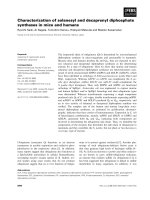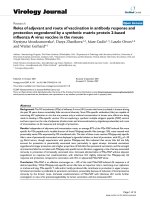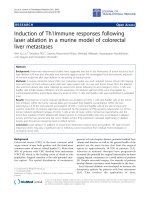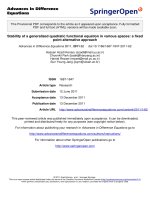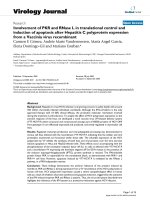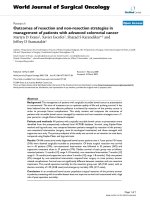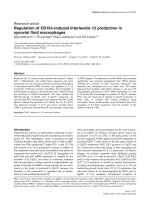Báo cáo sinh học: " Inferences of betweenfamily components of variance and covariance among environments in balanced cross-classified designs" pps
Bạn đang xem bản rút gọn của tài liệu. Xem và tải ngay bản đầy đủ của tài liệu tại đây (862.11 KB, 20 trang )
Original
article
Inferences
on
homogeneity
of
between-
family
components
of
variance
and
covariance
among
environments
in
balanced
cross-classified
designs
JL
Foulley
D
Hébert
2
RL
Quaas
3
1
Institut
National
de
la
Recherche
Agronomique,
Station
de
Génétique
Quantitative
et
Appliquée,
Centre
de
Recherches
de
Jouy-en-Josas,
78352
Jouy-en-Josas
Cedex;
2
Domaine
Expérimental
Agronomie
d’Auzeville,
Centre
de
Recherches
de
Toulouse,
BP
27,
31326
Castanet
Tolosan
Cedex,
hb
ance;
3
Cornell
University,
Department
of Animal
Science,
Ithaca,
NY
14853,
USA
(Received
4
August
1993;
accepted
29
November
1993)
Summary -
Estimation
and
testing
of
homogeneity
of
between-family
components
of
variance
and
covariance
among
environments
are
investigated
for
balanced
cross-classified
designs.
The
variance-covariance
structure
of
the
residuals
is
assumed
to
be
diagonal
and
heteroskedastic.
The
testing
procedure
for
homogeneity
of
family
components
is
based
on
the
ratio
of
maximized
log-restricted
likelihoods
for
the
reduced
(hypothesis
of
homogeneity)
and
saturated
models.
An
expectation-maximization
(EM)
algorithm
is
proposed
for
calculating
restricted
maximum
likelihood
(REML)
estimates
of
the
residual
and
between-family
components
of
variance
and
covariance.
The
EM
formulae
to
implement
this
are
iterative
and
use
the
classical
analysis
of
variance
(ANOVA)
statistics,
ie
the
between-
and
within-family
sums
of
squares
and
cross-products.
They
can
be
applied
both
to
the saturated
and
reduced
models
and
guarantee
the
solutions
to
be
in
the
parameter
space.
Procedures
presented
in
this
paper
are
illustrated
with
the
analysis
of
5
vegetative
and
reproductive
traits
recorded
in
an
experiment
on
20
full-sib
families
of
black
medic
(Medicago
lupulina
L)
tested
in
3
environments.
Application
to
pure
maximum
likelihood
procedures,
extension
to
unbalanced
designs
and
comparison
with
approaches
relying
on
alternative
models
are
also
discussed.
genotype
X
environment
interaction
/
heteroskedasticity
/
expectation-maxi-
mization
/
restricted
maximum
likelihood
/
likelihood
ratio
test
Résumé -
Inférence
relative
à
des
composantes
familiales
homogènes
de
variance
et
de
covariance
entre
milieux
dans
des
dispositifs
factoriels
équilibrés.
Cet
article
étudie
les
problèmes
d’estimation
et
de
test
d’homogénéité
des
composantes
familiales
de
variance
et
de
covariance
entre
milieux
dans
des
dispositifs
factoriels
équilibrés.
La
structure
des
variances
et
des
covariances
résiduelles
est
supposée
diagonale
et
hétéroscédastique.
La
procédure
de
test
d’homogénéité
des
composantes
familiales
repose
sur
le
rapport
des
vraisemblances
restreintes
maximisées
sous
les
modèles
réduit
(hypothèse
d’homogénéité)
et
saturé.
Un
algorithme
d’espérance-maximisation
(EM)
est
proposé
pour
calculer
les
estimations
du
maximum
de
vraisemblance
restreinte
(REML)
des
composantes
résiduelles
et
familiales
de
variance
et
de
covariance.
Les
formules
EM
à
appliquer
sont
itératives
et
utilisent
les
statistiques
classiques
de
l’analyse
de
variance
(ANOVA),
c’est-à-dire
les
sommes
de
carrés
et
coproduits
inter-
et
intrafamilles.
Elles
s’appliquent
à
la
fois
aux
modèles
réduit
et
saturé
et
garantissent
l’appartenance
des
solutions
à
l’espace
des
paramètres.
Les
méthodes
présentées
dans
cet
article
sont
illustrées
par
l’analyse
de
5
caractères
végétatifs
et
reproductifs
mesurés
lors
d’une
expérience
portant
sur
20
familles
de
pleins
frères
testées
dans
3 milieux
chez
la
minette
(Medicago
lupulina
L).
L’application
au
maximum
de
vraisemblance
stricto
sensu,
la
généralisation
à
des
dispositifs
déséquilibrés
ainsi
que
la
comparaison
à
des
approches
reposant
sur
d’autres
modèles
sont
également
discutées.
interaction
génotype
x
milieu
/
hétéroscédasticité
/
espérance-maximisation
/
maxi-
mum
de
vraisemblance
restreinte
/
rapport
de
vraisemblance
INTRODUCTION
There
is
a
great
deal
of
interest
today
in
quantitative
and
applied
genetics
in
heterogeneous
variances.
Ignoring
such
heterogeneity,
as
is
usually
done,
may
substantially
affect
the
reliability
of
genetic
evaluation
and
thus
reduce
the
efficiency
of selection
(Hill,
1984;
Visscher
and
Hill,
1992).
There
is
concern
not
only
about
estimating
dispersion
parameters
for
hetero-
skedastic
models,
but
also
about
testing
hypotheses
for
the
real
degree
of
hetero-
geneity
which
can
be
expected
from
experimental
results.
In
this
respect,
Visscher
(1992)
investigated
the
statistical
power
of
the
likelihood
ratio
test
in
balanced
half-sib
designs
for
detecting
heterogeneity
of
phenotypic
variance
and
intra-class
correlation
between
environments.
In
that
approach,
the
(family)
correlation
between
environments
(p)
is
assumed
to
be
equal
to
1,
and
heterogeneity
of
between-family
components
of
covariance
among
environments
in
only
due
to
scaling
of
variances.
The
aim
of
this
paper
is
to
extend
that
approach
to
the
case
of
true
genotype
by
environment
interactions
(p #
1).
Our
attention
will
be
focused
on:
i)
cross-
classified
balanced
designs;
and
ii)
the
null
hypothesis
involving
homogeneity
of
between-family
components
of
variance
and
covariance
between
environments.
This
variance-covariance
structure
has
been
widely
used
for
analyzing
family
data
recorded
in
different
environments,
in
particular
due
to
its
close
link
with
a
2-
factor
classification
model
(ie
family
and
environment)
with
interaction
(Mallard
et
al,
1983;
Foulley
and
Henderson,
1989).
Moreover,
even
for
balanced
designs,
the
estimation
of
the
2
parameters
involved
in
this
simple
structure
via
maximum
likelihood
procedures
has
no
analytical
solution
in
the
general
case
when
no
assumption
is
made
about
the
residual
variances.
This
motivated
the
proposal
made
in
this
study
to
use
the
expectation-maximization
(EM)
algorithm
(Dempster
et
al,
1977)
to
solve
the
problem.
THEORY
Generalities
Let
us
assume
that
the
records
from
the
balanced
cross-classified
layout
family
(or
genotype)
x
environment
can
be
written
as:
where
y2!!
is
the
performance
of
the
kth
progeny
(or
individual)
(k
=
1, 2, ,
n)
of
the
jth
family
(or
genotype)
( j
=
1,
2, ,
s)
evaluated
in
the
ith
environment
(i
=
1, 2, , p) ;
b
ij
is
the
random
effect
of
the
jth
family
in
the
ith
environment,
assumed
normally
distributed,
such
that
Var(b
ij
)
=
aB
i,
Cov(bij,bi
’
j)
=
O’Bii
,,
for
i
!
i’,
and
Cov(bi!,bi!!!)
=
0
for j # j’
and
any
i and
i’;
and
e2!k
is
a
residual
effect
pertaining
to
the
kth
progeny
in
the
subclass
ij,
assumed
A!77D(0, <7!)
viz,
normally
and
independently
distributed
with
mean
zero
and
variance
U2
wi
Using
vector
notation,
ie
y
jk
=
{
Yijk
}, !!
=
Igil
,
bj =
{bij}
and
ej
k
=
{e2!k}
for
i
=
1, 2, ,
p,
the
model
[1]
can
alternatively
be
written
as:
where
bj
rv
N(0,!3)
and
e
jk
rv
N(0,E!),
with
EB
=
{a-
Bii’
}’
standing
for
the
(p
x
p)
matrix
of
between-family
components
of
variance
and
covariance
between
environments
and
£w
=
Diag{
Qwi
} for
the
(p
x
p)
diagonal
matrix
of
residual
components
of
variance.
&dquo;
Actually,
this
approach
consists
of
considering
the
expression
of
the
trait
in
different
environments
(i, i’)
as
that
of
2
genetically
related
traits
with
a
coefficient
of
correlation
pii,
=
asi!!/!B!!s!&dquo;
(Falconer,
1952).
In
a
given
environment
(i),
this
1-way
linear
model
generates
the
classical
ANOVA
statistics,
ie
the
between-family
(SB!,
Bi)
and
within-family
(Swi,
Wi)
sums
of
squares
and
mean
squares,
respectively,
whose
distributions
are
propor-
tional
to
chi-squares:
Due
to
the
cross-classified
structure
of
the
design,
one
also
has
to
consider
a
sum
(S
B
,)
and
a
mean
(BZi!)
between-family
cross-product
for
each
(ii’)
combination
of
environments:
If
we
let
yj_ =
lyij. 1,
Y
=
{Yi },
then
the
matrix
SB
=
{BBi&dquo;}
} with
elements
from
[3a]
and
[4],
such
that:
&dquo;&dquo;
has
a
Wishart
distribution,
denoted
W(r,
s -
1),
with
parameters
(s —
1)
and
r
=
Eyv
+
nE
B,
thus
generalizing
to
a
matrix
of
between-family
sums
of
squares
and
cross-products
the
(o,2 w
i
+naBi)X!s_1!
distribution
arising
in
(3a!.
In
the
1-dimensional
case,
the
set
of
SB!
and
Sw.
are
independent,
location
invariant
sufficient
statistics
for
a-
1
and
wi
similarly
the
matrices
SB
and
Syv
=
Diag{5w,}
have
the
same
property
for
EB
and
Eyv.
Hence,
one can
write
the
density
of
[5]
as
Similarly,
Using
[6a]
and
[6b]
in
the
expression
for
the
log
likelihood,
where
Ct
is
a
constant.
This
leads
to:
with
W
=
Diag{W
d
=
Syv/s(n -
1)
and
tr(.)
=
the
trace
operator.
Notice
that
maximization
of
[7]
yields
REML
estimators
of
EB
and
Eyj,
because
the
marginally
sufficient
statistics
SB
and
Syir
are
used
in
the
log-likelihood
function.
Under
the
saturated
model
(a wi 2 7!
0
,2 Wi,
and
UBij
, 0
!8.!!.!!!
for
any
i, i’, i&dquo;
and
i&dquo;’),
the
partial
derivatives
with respect
to
oBg
and
0’
2
wi
of
minus
twice
the
log
likelihood
(-2L)
are:
’&dquo;
8F/8aB;;,
is
a
(p
x
p)
matrix
having n
as
the
(i,
i’)
element
and
0
elsewhere,
so
that
the
equation
[8a]
=
0
gives
f
=
B.
Similarly,
8£w /
8a/j
has
1
as
the
ith
diagonal
element
and
0
elsewhere.
Given
that
Ew
and
W are
diagonal
matrices
and
that
f
=
B,
the
solutions
to
equations
[8a]
=
0
and
[8b]
=
0
are
provided
that
B —
W
is
positive
definite.
The
maximum
of
the
log-likelihood
function
is
then
(apart
from
a
constant):
Otherwise,
REML
estimates
of
EB
and
EW
are
no
longer
identical
to
ANOVA
estimates
and
require
the
use
of
another
algorithm
for
their
calculation
(see
Appendix
A).
The
null
hypothesis
consists
of
assuming
the
homogeneity
of
the
between-family
components
of
variance
(’di,
or
2
=
CT
2
)
and
covariance
(Vi #
i’,
a-
Bii’
=
CB)
as
postulated
in
many
analyses
of genotype
by
environment
experiments
(Dickerson,
1962;
Yamada,
1962;
Mallard
et
al,
1983).
The
approach
presented
in
this
paper
allows
us
to
test
this
simplified
structure
of
EB
against
Falconer’s
saturated
model
for
any
structure
of
the
residual
variances.
The
nulle
hypothesis
(H
o)
considered
here
can
be
written
as:
where
Ip
=
identity
matrix
of
order
p
and
Jp
=
(p
x
p)
matrix
of
ones.
Under
Ho,
REML
estimation
of
EB
and
Eyv
becomes
much
more
complex.
Here
8F/8a
§
=
nIp
and ar/aC
B
=
n(J
P
-
Ip)
result
in
the
following
equations:
were
lp = (p x 1)
vector
of
ones.
Since
r-
1
-
I-
F-’BF-
1,
the
REML
solution
for
the
residual
components
([8b])
is
no
longer
Êw
=
W and
the
system
of
equations
[8b]
(see
also
(B11!),
[12a]
and
[12b]
has
no
analytical
solutions
in
the
general
case.
This
was
the
reason
motivating
our
search
for
another
approach
for
computing
REML
solutions
to
EB
and
£w
under
Ho.
An
EM
diagonalization
approach
The
expectation-maximization
approach
is
a
very
efficient
concept
in
maximum
likelihood
estimation
(Dempster
et
al,
1977).
It
has
been
widely
used
for
calculating
ML
and
REML
estimates
of
variance
components
of
linear
models
(Meyer,
1990 ;
-!
(auaas,
1992).
The
basic
principle
is
to
treat
the
unobservable
random
variables
b
ij
and
e2!!
as
missing
data.
Actually,
the
EM
algorithm
will
not
be
applied
directly
to
the
model
described
in
[1]
and
[2]
but
after
a
spectral
decomposition
of
EB
according
to
its
eigenvalues
and
vectors,
ie:
In
this
formula,
A
=
Diagf6
il
is
the
(p
x
p)
matrix
of
eigenvalues
6i,
with 6
i
repeated
as
many
times
as
its
multiplicity
order,
and
U
=
(U
1,
U2
, ,
Ui, ,
Up)
is
the
(p
x
p)
matrix
of
the
corresponding
p
normed
eigenvectors
Ui
of
EB
(U’U
=
IP
).
Under
the
special
form
shown
in
!11!,
EB
has
only
2
distinct
eigenvalues:
with
multiplicity
orders
1
and
(p —
1)
respectively.
Moreover,
the
matrix
U
of
eigenvectors
does
not
depend
on
the
values
of
61
and
62,
U’
being
the
Helmert
matrix
of
order
p,
see
for
example
Searle,
1982
(p
71
and
322)
for
more
details
about
such
matrices.
For
instance,
for
p
=
3,
Due
to
the
invariance
property
of
(RE)ML
estimators,
the
one-to-one
transfor-
mation
in
[14a]
and
[14b]
allows
us
to
change
the
parameterization
from
(<
T1,C
B)
to
(6
1
,b
2
),
or
more
conveniently
to
(<!i,T)
where
T
=
61
+
(p —
1)6
2,
the
back
transformation
is:
From
the
spectral
decomposition
of
E$,
the
model
in
[2]
can
be
written
as:
where
U
is
defined
as
before
and
the vector
fj
=
{ fi!
is
such
that
fj
N
N(0,A).
Using
the
Dempster
et
al
(1977)
terminology,
a
complete
data
set
x
can
be
constructed
from
/
-1,
fj,
e
jk
for j
=
1,2, ,s
and
k
=
1, 2, ,
n,
whereas
the
incomplete
data
set
is
the
vector
y
of
observations.
’
Let
us
first
consider
the
case
of
EB.
If
the
fj
’s
were
known,
sufficient
statistics
for
61
and
T
would
be,
under
the
normality
assumption:
REML
would
then
be
obtained
by
equating
the
expectation
of
these
sufficient
statistics,
ie:
to
their
calculated
values
(M
step).
Actually,
these
sufficient
statistics
are
not
directly
observable
and
the
EM
algorithm
proceeds
first
by
estimating
them
by
taking
their
conditional
expectation
given
the
observed
data
set
(E
step).
Since
such
an
estimation
depends
on
the
value
of
the
unknown
parameters,
the
procedure
is
iterative
and
consists
of
implementing
the
2
usual
steps:
E
step:
at
iteration
(t!,
calculate
M
step:
compute
6!&dquo;’I
and
T[t+
1]
from
the
following
equations:
As
shown
in
Appendix
A,
the
(p
x
p)
matrix
A’
l
can
be
expressed
as:
where
U,
B and
r
are
defined
as
above
(see
!13!,
[5a]
and
[5b]
respectively)
and
C!t!
is
the
matrix
of
variance
of
prediction
errors
of
[
t]
=
E(f
j
)
y,
8!t] ,
r
[t]
,
S!),
the
best
predictor
of
fj
at
iteration
[t]
such
that:
Similarly,
sufficient
statistics
for
Ew
under
the
complete
data
set
x
are:
and
the
E
and
M ’steps
are
as
follows:
’
For
the
E
step,
at
iteration
[t],
calculate:
using
the
following
formula
based
on
the
same
reasoning
as
previously
(see
Ap-
pendix
A):
sums
of
squares
and
cross-products
(y
being
defined
as
For
the
M
step
compute
the
next
value
of
Eyv
from:
Formulae
[25]
and
[24a]-[24b]
define
the
E
and
M
steps,
respectively,
of
an
EM
procedure
equivalent
to
that
described
previously
but
applied
to
untransformed
parameters.
Notice
that
in
this
scheme
tr(P)/p
(average
diagonal
element
of
P)
and
((1’P1) -
tr(P!!/p(p -
1)
(average
off-diagonal
element
of
P)
behave
as
sufficient
statistics
for
aB
and
CB
with
respect
to
the
complete
data
set.
Formulae
for
the
residual
components
are
unchanged
with
UC
[t]
U’
=
:E
W
1 E!y!
and
M[
t]
=
n£ §
I
(r
iti
1
. For
the saturated
model,
the
formulae
to
apply
are
the
same
for
EW
and,
simply,
Eft+
&dquo;
=
Il
ltl
ls
for
EB.
Testing
procedures
Hypotheses
of
interest
concern
the
vector
0
of
parameters
involved
in
the
matrices
of
between-family
(E
B)
and
within-family
(Ey!)
components
of
variance
and
covariance
between
environments.
The
theory
of
the
generalized
likelihood
ratio
can
be
applied
to
that
purpose,
as
already
proposed
by
Foulley
et
al
(1990,
1992),
Shaw
(1991)
and
Visscher
(1992)
among
others.
Let
Ho
:
0
E
80
be
the
null
hypothesis
and
HI
:
0
6
8
-
80
its
alternative,
where
8
refers
to
the
complete
parameter
space
and
Oo,
a
subset
of
it
pertaining
to
Ho.
Under
Ho,
the
statistic
where
L(0;y)
is
defined
as
in
!7!,
has
an
asymptotic
chi-square
distribution
with
r
degrees
of
freedom,
r
being
the
difference
in
the
numbers
of
estimable
parameters
involved
in
e
and
Oo
(Mood
et
al,
1974).
Here
e
contains
p(p
+
3)/2
parameters
corresponding
to
p
residual
components
of
variance
and
p(p
+
2)/2
between-family
components
of
variance
and
covariance
between
environments
whilst
Oo
has
p+2
2 parameters
only
(p
residual
components,
<T1 and
CB
),
so
that
r
=
!p(p+
1)/2! -
2.
In
the
Neyman-Pearson
approach
of
hypothesis
testing,
Ho
is
rejected
at
the
a
level
if
the
calculated
value
of
A(y)
exceeds
a
critical
value
Àc
such
that
Pr(xr >
Àc)
=
a.
However,
the
likelihood
ratio
statistic
.!(y)
in
[24]
can
also
be
interpreted
as
the
difference
in
degree
of
fit
via
maximum
likelihood
procedures
by
2
models:
a
reduced
model(R)
with
parameter
vector
0
E
Oo
and
a
full
model
(F)
with
0
E
O
encompassing
both
the
null
hypothesis
and
its
alternative.
In
the
theory
of
significance
testing
(Kempthorne
and
Folks,
1971),
this
statistic
is
also
used
as
a
measure
of
strength
of
evidence
against
the
reduced
model
or
the
null
hypothesis.
The
lower
the
probability
under
Ho
of
exceeding
this
statistic
evaluated
from
the
data
(also
referred
to
as
the
P-value
or
significance
level
or
size
of
the
test),
the
stronger
the
evidence
against
Ho.
Example
Data
used
here
to
illustrate
the
procedures
are
from
an
experiment
carried
out
in
Montpellier
(south
west
of
France)
on
20
full-sib
families
of
black
medic
(Medicago
lupulina
L)
tested
in
3
different
environments
(control,
harvesting
and
competition
treatments).
The
experimental
design
was
described
in
detail
by
H6bert
(1991).
There
were
2
replicates
per
environment
and
the
20
genotypes
were
randomly
allocated
to
each
replicate.
Thirty-six
traits
were
recorded
and
the
variable
used
was
the
mean
of
the
5
plants
cultivated
in
each
replicate
so
that
p
=
3,
s
=
20
and
n
=
2.
Basic
ANOVA
statistics
for
the
between-family
and
within-family
sums
of
squares
and
cross-products
are
given
in
table
I
for
a
subset
of
5
traits.
Firstly,
the
null
assumption
that
the
diagonal
terms
of
Ew
were
equal
was
tested
via
a
Bartlett’s
test
based
on
ANOVA
mean
squares
statistics.
P
values
were
0.007,
0.08, 1.4
x
10-
7,
8 x
10’!
and
0.04
so
that
this
assumption
can
be
reasonably
rejected
(except
perhaps
for
trait
2).
Test
statistics
about
EB
and
estimates
of
EB
and
£w
under
both
the
reduced
and
saturated
models
are
given
in
table
II.
P-values
for
vegetative
yield
traits,
represented
here
by
dry
matter
weight
(trait
No
3)
and
dry
matter
weight/max
plant
size
diameter
(trait
No
4),
were
very
low,
indicating
a
large
heterogeneity
in
genetic
variation
between
evironments
with
full-sib
variances
substantially
reduced
in
the
harvesting
(i
=
1)
and
competition
(i
=
3)
environments
compared
with
the
control
(i
=
2).
In
contrast,
the
harvesting
and
competition
environments
do
not
generate
a
meaningful
level
of
stress
compared
with
the
control
for
the
expression
of
genetic
variation
of
days
to
1st
ripe
pod
(trait
No
2)
and
relative
pod
weight
(trait
No
5).
These
3
environments
then
behave
as
’exchangeable’,
as
statisticians
would
say.
In
this
example,
genetic
correlations
between
environments
were
rather
high
and
it
would
have
been
interesting
to
test
for
some
traits
(eg
No
1
and
5)
using
the
assumption
that
these
correlations
are
equal
to
unity
by
Visscher’s
(1992)
procedures.
This
paper
describes
a
further
contribution
to
the
solution
of
the
problem
of
testing
homogeneity
of
between-family
components
of
variance
and
covariance
between
environments
in
the
case
of
balanced
cross-classified
designs.
The
testing
procedure
is
based
on
the
likelihood
ratio
test
as
already
advocated
by
Shaw
(1987)
in
quantitative
genetics.
This
study
extends
that
of
Visscher
(1992),
which
was
restricted
to
the
case
of
pure
scaling
effects
between
environments
(ie
all
genetic
correlations
between
environments
equal
to
one).
The
choice
of
an
EM
algorithm
for
computing
REML
estimates
of
EB
and
Ew
under
the
null
hypothesis
allows
us
to
make
explicit
the
equations
of
the
iterative
process
to
implement
via
formulae
based
on
the
usual
ANOVA
statistics.
This
algorithm
does
not
require
any
constraint
on
the
value
of
these
ANOVA
statistics
( eg
B -
W
can
be
non-positive
definite)
provided
the
starting
values
for
EB
are
within
the
parameter
space.
A
simple
reason
for
this
is
that
the
E
phase
under
the
restricted
model
involves
the
conditional
expectation
(given
the
data)
of
sums
of
squares,
eg
£ f£
and
e
e !!
as
estimators
of
variance.
Because
E
(L
flf
ly,
A = 8!t! )
is
j
7
k
j
,
always
positive
definite
(Foulley
et
al,
1987),
this
property
of
the
EM
algorithm
is
also
true
under
the
saturated
model;
it
can
then
be
used
to
provide
REML
estimates
of
EB
and
Ew
when
ANOVA
estimators
are
not
permissible
(eg
for
traits
1,
3,
4
and
5
in
the
example).
Some
authors
such
as
Anderson
(1984)
and
Shaw
(1987)
advocate
the
use
of
ML
rather
than
REML
procedures
to
test
hypotheses
about
variance
covariance
matrices.
Our
EM
algorithm
can
be
easily
adapted
to
obtain
such
ML
estimates
of
EB
and
Ew.
It
suffices
to
replace
(s-1)B+r
in
formulae
[19]
and
!21!
for
A
and
Q
respectively
by
(s-1)B
corresponding
to
the
change
in
the
conditional
expectation
(given
the
data)
of n (y
j
. -
p) (yj_ -
!)’
according
to
whether g
is
considered
as
j
a
parameter
of
interest
(ML)
or
a
nuisance
factor
to
be
integrated
out
(REML).
This
algorithm
can
also
retrieve
the
usual
ANOVA
estimates
for
EB
and
Ew
using
the
2-way
crossed-mixed
model:
involving
fixed
environmental
effects
(h
i
),
random
family
effects
[s
j
- NIID (0, a/ ) ] ,
random
interactions
[hs
ij -
NIID(0,afl!)]
and
residuals
[e
ijk
°° NIID(0,a
£
)].
In
fact,
Foulley
and
Henderson
(1989)
showed
that
this
is
an
equivalent
model
for
a
simplified
version
of
the
multiple
trait
model
in
[1]
restricted
to
EB
=
(
U2
B -
CB
)Ip
+ C
B
Jp
and
Ew
=
Q!2,yIP
with
0,2 B
=
Qs
+
or2!’, h
CB
= or
.
and
ow
2
=
O
re.
2
Notice
however
that
this
simplified
multiple
trait
model
differs
from
that
considered
throughout
this
study
(see
[11])
not
only
by
the
assumption
of
homoskedastic
residual
variances
but
also
by
its
restriction
to
a
positive
covariance
(C
B)
between
environments.
For
instance,
for
trait
1
(days
to
flowering),
EM-REML
estimates
of
variance
and
covariance
components
obtained
from
the
algorithm
described
in
[17]
to
[22]
with
a-
W+1]
=
tr(fl!’1)/nsp
in
[23]
are:
Q2 B
=
80.86 !
CB
=
79.89 !
and
Q2 W
=
26.39.
These
values
can
easily
be
checked
with
ANOVA
estimatps:
a2
=
79.89;
&2,
=
0.97;
and
a2
=
26.39.
Here
again,
the
EM
algorithm
provides
estimates
within
the
parameter
space,
which
is
not
always the
case
with
ANOVA
estimators
as
shown
for
instance
with
trait
5 :
&1 =
79.50,
CB
=
79.43
and
a2
= 23.23
with
EM
versus as
=
79.65,
!hs
=
-1.02
and
Qe
=
24.07
with
ANOVA.
The
EM
algorithm
is
a
first-order
procedure
and
therefore
has
close
relationships
with
a
maximization
procedure
based
on
zeroed
first
derivatives.
As
shown
in
Appendix
B
in
the
case
of
EB,
the
difference
between
the
formulae
to
implement
in
the
2
iterative
procedures
consists
of
replacing
(s -
1)B
+
r!t!
in
[19]
by
sB
in
the
1st
derivative
algorithm
(B
being
a
sufficient
statistic
for
r
in
the
saturated
model).
Again,
the
use
of
EM
guarantees
staying
in
the
parameter
space
whereas
there
is
no
obvious
proof
of
that
for
the
1st
derivative
algorithm.
Moreover,
the
EM
approach
turns
out
to
be
easier
to
understand
and
to
use
than
the
other
one,
which
relies
mainly
on
algebraic
tricks.
As
far
as
REML
estimates
of
£w
are
concerned,
a
functional
iteration
algorithm
based
on
first
derivatives
was
also
proposed
in
Appendix
B
due
to
the
lack of
an
obvious
analogue
of
the
EM
formulae.
Finally,
this
EM
reasoning
can
be extended
to
an
unbalanced
structure
of
data
and
to
additional
nuisance
fixed
effects
cross-classified
with
family
effects,
ie
to
an
extended
version
of
model
[1]
such
as
where
13
is
a
vector
of
fixed
effects
including
the
ith
classification
for
environment
and
effects
of
other
factors
to
be
adjusted
for,
and
x’ij
k
is
the
corresponding
incidence
(row)
vector.
Under
that
model,
the
E
and
M
steps
defined
in
[17]
and
[18a]
and
[18b]
for
EB
and
in
[21]
and
[23]
for
Ew
are
still
valid.
However,
the
E-
statistics
in
!17!,
[21]
and
[24b]
are
not
evaluated
as
functions
of
ANOVA
statistics
but
directly
from
the
numerical
values
of
the
BLUP
and
the
variance
of
prediction
errors
of
the
fj
or
b!’s.
In
this
situation,
also,
the
EM
algorithm
should
be
applied
systematically
to
both
the
reduced
and
saturated
model
for
Ey!.
Another
approach
would
be
to
write
[28]
under
its
equivalent
form
(for
CB
>
0):
where
hi, sj
and
hsjj
are
defined
as
in
[25]
and
e2!! N
NID(O,
o,2w.).
Under
such
a
mixed-model
structure,
one
can
then
use
the
methods
developed
by
Foulley
et
al
(1990,
1992)
and
San
Cristobal
et
al
(1993)
for
calculating
REML
estimates
of
variances
in
the
presence
of
heterogeneous
residual
components.
However,
the
procedure
derived
in
this
paper
remains
definitively
more
general,
for
instance,
it
can
also
be
easily
applied
to
a
non-diagonal
structure
of
Ew
using
formulae
[17]
to
[22]
unchanged
and
[23]
slightly
modified
into
E!+l]
=
S2!t!/ns.
This
paper
deals
with
a
null
hypothesis
of
constant
between-family
variance
and
covariance.
In
some
instances,
a
more
appropriate
null
hypothesis
would
be
a
constant
between-family
correlation
(p)
between
environments
(a-
B
ii
’
=
/9<?’B,<!B,/)
and/or
of
constant
intraclass
correlation
[a-1i
=
t(a-1i
+
or2
wi
)].
Testing
procedures
for
these
assumptions
will
be
reported
in
a
separate
article.
&dquo;
ACKNOWLEDGMENTS
The
authors
are
grateful
to
I
Olivieri
(INRA,
Montpellier)
for
stimulating
discussions
which
motivated
this
study,
to
J
Ruane
for
the
English
revision
of
the
manuscript
and
to
the
anonymous
referees
for
their
valuable
comments.
Special
thanks
are
expressed
to
C
Robert
and
M
San
Cristobal
who
read
the
manuscript
thoroughly
and
checked
the
numerical
example.
REFERENCES
Anderson
TW
(1984)
An
Introduction
to
Multivariate
Statistical
Analysis.
J
Wiley
and
Sons,
New
York
Dempster
AP,
Laird
NM,
Rubin
DB
(1977)
Maximum
likelihood
from
incomplete
data
via
the
EM
algorithm.
J R
Statist
Soc
B
39,
1-38
Dickerson
GE
(1962)
Implications
of
genetic-environmental
interaction
in
animal
breeding.
Anim
Prod
4, 47-63
Falconer
DS
(1952)
The
problem
of
environment
and
selection.
Amer
Nat
86,
293-
298
Foulley
JL,
Henderson
CR
(1989)
A
simple
model
to
deal
with
sire
by
treatment
interactions
when
sires
are
related.
J
Dairy
Sci
72,
167-172
Foulley
JL,
Im
S,
Gianola
D,
Hoeschele
I
(1987)
Empirical
Bayes
estimation
of
parameters
for n
polygenic
binary
traits.
Genet
Sel
Evol 19,
197-224
Foulley
JL,
Gianola
D,
San
Cristobal
M,
Im
S
(1990)
A
method
for
assessing
extent
and
sources
of
heterogeneity
of
residual
variances
in
mixed
linear
models.
J
Dairy
Sci
73,
1612-1624
Foulley
JL,
San
Cristobal
M,
Gianola
D,
Im
S
(1992)
Marginal
likelihood
and
Bayesian
approaches
to
the
analysis
of
heterogeneous
residual
variances
in
mixed
linear
Gaussian
models.
Comput
Stat
Data
Anal
13,
291-305
H6bert
D
(1991)
Plasticite
ph6notypique
et
interaction
genotype
milieu
chez
Medi-
cago
Lupulina.
These
Doctorat
Sciences.
Univ
Sciences
Techniques
du
Languedoc,
Montpellier
Hill
WG
(1984)
On
selection
among
groups
with
heterogeneous
variance.
Anim
Prod
39,
473-477
Kempthorne
0,
Folks
L
(1971)
Probability,
statistics
and
data
analysis.
The
Iowa
State
University
Press,
Ames
(10)
Mallard
J,
Masson
JP,
Douaire
M
(1983)
Interaction
genotype
x
milieu
et
mod6le
mixte.
I.
Mod6lisation.
Genet
Sel
Evol
15,
379-394
Meyer
K
(1990)
Present
status
of
knowledge
about
statistical
procedures
and
algorithms
to
estimate
variance
and
covariance
components.
In:
4th
World
Congress
on
Genetics
Applied
to
Livestock
Production,
Edinburgh,
23-27
July
1990,
vol
13,
(WG
Hill,
R
Thompson,
JA
Wooliams,
eds),
407-418
Mood
A,
Graybill
FA,
Boes
DC
(1974)
Introduction
to
the
Theory
of
Statistics.
Mc
Graw-Hill
Inc,
London
(auaas
RL
(1992)
REML
NoteBook.
Mimeo,
Dep
Anim
Sci,
Cornell
Univ
Ithaca
(NY)
San
Cristobal
M,
Foulley
JL,
Manfredi
E
(1993)
Inference
about
multiplicative
heteroskedastic
components
of
variance
in
a
mixed
linear
Gaussian
model
with
an
application
to
beef
cattle
breeding.
Genet
Sel
Evol
25,
3-30
’
Searle
SR
(1982)
Matrix
Algebra
Useful
to
Statistics.
J
Wiley
and
Sons,
New
York
Shaw
RG
(1987)
Maximum
likelihood
approaches
applied
to
quantitative
genetics
of
natural
populations.
Evolution
41,
812-826
Shaw
RG
(1991)
The
comparison
of
quantitative
genetic
parameters
between
populations.
Evolution
45,
143-151
Visscher
PM
(1992)
On
the
power
of
likelihood
ratio
tests
for
detecting
heterogene-
ity
of
intra-class
correlations
and
variances
in
balanced
half-sib
designs.
J
Dairy
Sci
75,
1320-1330
Visscher
PM,
Hill
WG
(1992)
Heterogeneity
of
variance
and
dairy
cattle
breeding.
Anim
Prod
55,
321-329
Yamada
Y
(1962)
Genotype
by
environment
interaction
and
genetic
correlation
of
the
same
trait
under
different
environments.
Jap
J
Genet
37,
498-509
APPENDIX
An
EM
algorithm
for
REML
estimations
of E
B
and
Ew
(part
A)
EB
and
Eyv
under
Ho
An
explicit
formula
for
A
can
be
obtained
by
successively
conditioning
and
deconditioning
the
expression
in
[17]
with
respect
to
the
mean
vector
p,
ie:
where
0
stands
for
the
vector
of
parameters
involved
in
the
matrices
of
between-
family
(E
B)
and
within-family
(E
w)
components
of
variance
and
covariance
between
environments
and
0 1’
is
the
current
estimate
of
0
at
iteration
!t!.
s
Now,
conditionally
on
y, p
and
0
=
0’
l
,
the
expectation
of
Ef
jf
can
be
j=
1
decomposed
into:
This
decomposition
is
especially
helpful
because
it
allows
us
to
introduce
the
usual
statistics
of
Gaussian
models,
ie
the
conditional
mean
fj
=
E(f!
ly,
1-1,
e)
and
its
prediction
error
variance
Cj
=
Var(f! !y,
!,
0).
Here,
we
have:
The
next
step
is
to
specify
the
expression
for:
with
respect
to
the
distribution of
41y,
e.
On
account
of
assumptions
made
in
!1),
the
distribution
of
this
random
variable
is
N[y ,
(EB/s)
+
(Ew/ns)),
so
that:
The
formula
for
the
variance
of
prediction
error
in
[A3b]
does
not
depend
on
p,
so
that
the
expression
of
(Al]
reduces
to:
where
C!t!
is
defined
as
in
[A3b]
using
0!
as
a
current
estimate
of
0
in
Ew
and
EB,
the
matrices
B and
U
being
constant
over
rounds
of
iteration.
The
next
values
of
the
unknown
components
of
EB
(ie
aB
and
CB
or
61
and
T)
are
computed
at
the
M
step
from
the
diagonal
elements
of
A’
l
(!18a!
and
!18b!).
The
diagonal
terms
of
the
matrix
Ew
under
the
complete
data
set
x
since:
Because
this
statistic
is
not
observable,
it
is
replaced
by
its
conditional
expec-
tation
given
the
data
y
and
e
=
9!.
As
for
B-components,
this
expectation
is
calculated
after
conditioning
and
deconditioning
with
respect
to
the
mean
vector
!,
ie:
By
definition
of
a
quadratic
form,
one
has:
where
&dquo;
0
and
C
are
as
before.
From
[A9a],
the
quadratic
L êjkêjk
can
be
written
as
jk
with
M
=
nUCU’E-1
The
next
step
is
to
take
the
expectation
of
each
element
in
the
right-hand
side
with
respect
to
the
distribution of
gly,
0.
Then
where
T
designates
the
matrix
of
total
mean
squares
and
mean
cross-products,
Similarly,
Placing
[All],
[A12]
and
[A13]
in
[A8]
and
noting
that
the
conditional
variance
in
[A9b]
does
not
depend
on
!,
gives
In
fact, ft
is
evaluated
conditionally
on
0
=
0!,
ie
by
taking
F
=
Fl’],
C
=
Cl’l
and
M
=
M’
l
in
[A. 14].
The
next
value
of
or
2
wi
is
obtained
from
[A.6]
(M
step)
with
Qii
replacing
Q
ii
,
ie
by
o, 2[t
+l]
-
!2[t]/ns.
EB
and
Eyjr
under
the
saturated
model
Actually,
the
EM
algorithm
described
previously
can
be
easily
accomodated
to
deal
with
the saturated
model.
This
is
especially
helpful
when
the
ANOVA
estimates
of
EB
fall
outside
the
parameter
space.
Nothing
is
changed
with
respect
to
Eyv,
which
has
the
same
diagonal
structure
with
p
different
elements
in
both
situations.
As
far
as
EB
is
concerned,
a
sufficient
statistic
under
the
complete
data
set
is
now
the
(p
x
p)
matrix
bjb
’. 3
j
U ( ! f! f! ) U’.
However,
for
a
given
U,
the
general
expression
of
the
conditional
j
expectation
of
L:
fj f)
given
the
data
was
already
derived
(see
[19]
and
[A5],
so
that
j
the
E
step
remains
the
same.
Because
all
the
elements
of
A
are
now
required,
the
changes
to
implement
at
the
M
step
are
the
following:
compute
the
next
value
I:!+1]
of
EB
(saturated
model)
by
where
A’
l
is
obtained
from
[A5]
with
UM
being
the
matrix
of
normed
eigenvectors
of
EW.
Notice
that
here
U
is
updated
at
each
iteration
from
the
equation
E[t]U
lt]
=
U[t]![t].
Algorithms
based
on
first
derivatives
(part
B)
Between
family
components
EB
Using
the
spectral
decomposition
in
!13!,
ie
r
=
nU’!U
+
Ew,
we
obtain
where
Uip
Ui
2
>&dquo;&dquo;
Uie, ,
Uir-
are
the ri
normed
eigenvectors
of
EB
correspond-
ing
to
the
eigenvalue 6
i
with
multiplicity
order
ri.
Remember
that
under
the
reduced
model,
rl
=
1
and
r2
=
p —
1
for
61
and
62
defined
in
[14a]
and
[14b],
respectively.
Substituting
8F /861
by
its
expression
[B1]
in
the
equation
<9(-2L)/<9<*’t
=
0
leads
to:
Let
L
=
vn:U ! 1/2
with
L
partitioned
in
the
same
way
as
U,
ie
Lie
=
vn
-
6iUi,,
the
system
[B2]
is
then
equivalent
to:
where
(A)
i£ie
stands
for
the
if
th
diagonal
element
of
the
A
matrix.
Now:
and
with
Then,
from
and
Furthermore:
or
so
that
and
Using
[B7]
and
!B8!,
the
system
[B3]
reduces
to
The
EM
procedure
described
in
(18a!,
[18b]
and
[19]
can
be
alternatively
written
as
The
parallel
between
[B9]
and
[B10]
is
straightforward.
Here
B
replaces
((s -
1)B
+
r!/s,
since
these
2
quantities
have
the
same
expectation
F
under
the
saturated
model.
Residual
components
Ew
<9F
OEW
(OEW !
OEW
!v!. !
Here,
ar - a!2 , C a!2 J -
1
and 2
=
0 for
any
i
! i’.
Then,
the
a!W -
0,W!
a
B!!.A.’
equation
[8b]
=
0
can
be
written
as
Equation
!B11!
defines
a non-linear
system
that
can
be
solved
iteratively
using,
for
example,
the
functional
iteration
approach
